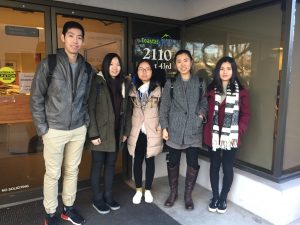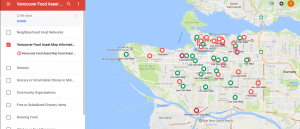We are now halfway through the course. As we are making food asset map videos in English, Mandarin and Cantonese for the community, our goal is to educate individuals on how to effectively use the map.
Here is the proposal of our project:
Weekly Objectives and Achievements
Week 1
Objectives:
– Choose a project that we are interested in and sign up for it
Achievements:
– Students picked top three projects from the community projects list based on their strengths
Week 2
Objectives:
– Meet with group members and have a basic understanding about the project after the introduction by our TA
Achievements:
– Shared information such as habits, major and contact
– Identified each other’s strengths and assigned tasks for individuals
– Created a Chat room as our main form of communication
Week 3
Objectives:
– Started to write blog post one
– Meet with our community partner Teya from Vancouver Coastal Health
Achievements:
– Our community partner provided many detailed instructions which allowed us to have a better understanding of our roles
– Based on all team members’ opinions, we successfully completed blog post one
Week 4
Objectives:
– Discuss the project proposal and assign different sections of the proposal for each individual
Achievements:
– Classified our project aim and objectives
– Wrote a draft proposal and waited for feedback
Week 5
Objectives:
– Revise the group proposal according to the feedback
Achievements:
– Completed a well-written project proposal on time
Week 6
Objectives:
– Arrange a meeting with the computer technician to ask questions about the video software that we are using
Achievements:
– Received a response from the technician, who recommended several software for us to use
– Group decided to use the multi-functioned software, Camtasia
What?
The population growth in Vancouver has been increasing steadily due to the increase of immigration to the city. With that in mind, food security needs to be ensured to the new immigrants as well. Therefore, Vancouver Coastal Health, UBC and our community partners created a food assets map. The food assets map is a relatively new tool that helps people allocate, buy, prepare and receive food. To increase the number of users of the food assets map, our strategy is to create an instructional video in English, Mandarin and Cantonese.
While making this video, we also have the chance to meet with one of the computer technicians from UBC to gain more knowledge about video filming techniques, such as vivid voiceover, classic animation and abundant pictures.
So what?
By making videos in three different languages, we hope that this tool can reach out to people who are more comfortable using Mandarin and Cantonese. It is important to recognize Vancouver’s diversity and our project helps to accomplish this bridging the gap between the Chinese community and the rest of Vancouver’s population.
Now what?
Ernesto Sirolli (2012) states that listening and working with different community members can achieve success. With knowledge from the technician and community partners, we are currently in the process of filming a convincing, yet educational video. As we are continuing to work on our project, our goal is to make our video easy to use and follow. In addition, we want to be able to show people how to use the food assets map in order to make the map a useful tool in their lives. We also hope to receive feedback from our community partners to test the effectiveness of our videos.
Upcoming Objectives:
Week 7
Objectives:
– Filming the video and voiceover
Strategies:
– Insert some pictures to make the video more appealing and engaging
– Read the script with more emotion to avoid being monotone
Week 8
Objectives:
– Edit the video
Strategies:
– Use knowledge learned from technician and apply it to our editing
Week 9
Objectives:
– Play the video to community partners
Strategies:
– Receive constructive feedback and make changes to the video
Week 10
Objectives:
– Write a report on the video making process
Strategies:
– Recall video making process and discuss results, implications and improvements
References:
Siroli, E. (2012, November 26). Want to help someone? Shut up and listen! [Video file]. Retrieved from https://www.youtube.com/watch?v=chXsLtHqfdM


